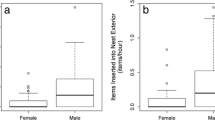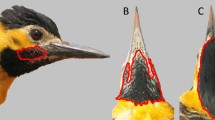Abstract
Indirect fitness benefits are believed to be an important force behind the evolution of cooperative breeding. However, helpers may associate with their relatives as a result of delayed dispersal, hence, kin associations might be a consequence of demographic viscosity rather than active choice. In addition, recent studies showed that helpers may have access to reproduction therefore direct benefits might also play an important role. Here, we investigate the possible roles of direct genetic benefits and kin associations on helping behavior in the sociable weaver Philetairus socius, a colonial and cooperatively breeding passerine. We used a microsatellite-based genotyping method to describe the genetic structure within nests and colonies. Within a colony, we found considerable genetic structure between males but not females. Sociable weaver colonies have several nests that are simultaneously active, giving individuals a choice of associating with a range of first-order kin to unrelated individuals. Helpers were significantly more related to the young in the helped nests than in other nests of the colony, suggesting an active choice for associating with kin. The helpers were generally offspring or first-order relatives of one (50%) or both (43%) breeders, although more infrequently, seemingly unrelated individuals also helped (7%). We found no supporting evidence of extrapair parentage and hence no direct genetic gains from helping in our population. This strong reproductive skew is contrary to theoretical models predicting conflicts over reproduction in stepfamilies. We discuss whether female decisions and/or other direct benefits of remaining in kin associations or helping might explain the high skew observed.

Similar content being viewed by others
References
Baglione V, Canestrari D, Marcos JM, Ekman J (2003) Kin selection on cooperative alliances of carrion crows. Science 300:1947–1949
Canestrari D, Marcos JM, Baglione V (2005) Effect of parentage and relatedness on the individual contributions to cooperative chick care in the carrion crow Corvus corone corone. Behav Ecol Sociobiol 57:422–428
Cant MA (1998) A model for the evolution of reproductive skew without reproductive suppression. Anim Behav 55:163–169
Chao L (1997) Evolution of polyandry in a communal breeding system. Behav Ecol 8:668–674
Chomczynski P, Mackey K, Drews R, Wilfinger W (1997) DNAzol: a reagent for the rapid isolation of genomic DNA. Biotechniques 22:550–553
Clarke MF (1989) The pattern of helping in the bell miner (Manorina melanophrys). Ethology 80:292–306
Clutton-Brock TH, Gaynor D, McIlrath GM, MacColl ADC, Kansky R, Chadwick C, Manser M, Skinner JD, Brotherton PNM (1999) Predation, group size and mortality in a cooperative mangoose, Suricata suricatta. J Anim Ecol 68:672–683
Clutton-Brock TH, Brotherton PNM, O’Riain MJ, Griffin AS, Gaynor D, Kansky R, Sharpe LL, McIlrath GM (2001) Contributions to cooperative rearing in meerkats, Suricata suricatta. Anim Behav 61:705–710
Cockburn A (1998) Evolution of helping behaviour in cooperatively breeding birds. Ann Rev Ecolog Syst 29:141–177
Cockburn A (2004) Mating systems and sexual conflict. In: Koenig WD, Dickinson JL (eds) Ecology and evolution of cooperative breeding in birds. Cambridge Univ. Press, Cambridge, pp 81–101
Covas R (2002) Life history evolution and cooperative breeding in the sociable weaver. In: Percy FitzPatrick Institute. University of Cape Town, Cape Town
Covas R, du Plessis MA (2005) The effect of helpers on artificially increased brood size in sociable weavers (Philetairus socius). Behav Ecol Sociobiol 57:631–636
Covas R, Doutrelant C, du Plessis MA (2004) Experimental evidence of a link between breeding conditions and the decision to breed or to help in a colonial cooperative breeder. Proc R Soc Lond B 271:827–832
Dickinson JL (2003) Male share of provisioning is not influenced by actual or apparent loss of paternity in western bluebirds. Behav Ecol 14:360–366
Dickinson JL (2004) A test of the importance of direct and indirect fitness benefits for helping decisions in western bluebirds. Behav Ecol 15:233–238
Don RH, Cox PT, Wainwright BJ, Baker K, Mattick JS (1991) Touchdown PCR to circumvent spurious priming during gene amplification. Nucleic Acid Res 19:4008
Doutrelant C, Covas R, Caizergues A, du Plessis MA (2004) Unexpected sex ratio adjustment in a colonial cooperative bird: pairs with helpers produce more of the helping sex whereas pairs without helpers do not. Behav Ecol Sociobiol 56:149–154
Dunn PO, Cockburn A (1999) Extra-pair mate choice and honest signaling in cooperatively breeding superb fairy-wrens. Evolution 53:938–946
Ekman J, Bylin A, Tegelström H (1999) Increased lifetime reproductive success for Siberian jay (Perisoreus infaustus) males with delayed dispersal. Proc R Soc Lond B 266:911–915
Ekman J, Bylin A, Tegelström H (2000) Parental nepotism enhances survival of retained offspring in the Siberian jay. Behav Ecol 11:416–420
Ekman J, Baglione V, Eggers S, Griesser M (2001) Delayed dispersal: living under the reign of nepotistic parents. Auk 118:1–10
Emlen ST (1997) Predicting family dynamics in social vertebrates. In: Krebs JR, Davies NB (eds) Behavioural ecology: an evolutionary approach, 4th edn. Blackwell Science, Cambridge, pp 228–253
Goodnight KF (2000) Relatedness 5.0. Goodnight software. Houston, Texas
Green DJ, Cockburn A (2001) Post-fledging care, philopatry and recruitment in brown thornbills. J Anim Ecol 70:505–514
Griffin AS, West SA (2002) Kin selection: fact and fiction. Trends Ecol Evol 17:15–21
Griffin AS, West SA (2003) Kin discrimination and the benefit of helping in cooperatively breeding vertebrates. Science 302:634–636
Griffith SC, Stewart IRK, Dawson DA, Owens IPF, Burke T (1999) Contrasting levels of extra-pair paternity in island and mainland populations of the house sparrow (Passer domesticus): is there an island effect? Biol J Linn Soc 68:303–316
Griffith SC, Owens IPF, Thuman KA (2002) Extra pair paternity in birds: a review of interspecific variation and adaptive function. Mol Ecol 11:2195–2212
Griffiths R, Double MC, Orr K, Dawson RJG (1998) A DNA test to sex most birds. Mol Ecol 7:1071–1075
Hamilton WD (1964) The genetical evolution of social behaviour II. J Theor Biol 7:17–52
Heinsohn R, Dunn PO, Legge S, Double MC (2000) Coalitions of relatives and reproductive skew in cooperatively breeding white-winged choughs. Proc R Soc Lond B 267:243–249
Jones AG, Ardren WR (2003) Methods of parentage analysis in natural populations. Mol Ecol 12:2511–2523
Keller L, Reeve HK (1994) Partitioning of reproduction in animal societies. Trends Ecol Evol 9:98–102
Koenig WD, Pitelka FA (1979) Relatedness and inbreeding avoidance: counter ploys in the communally nesting acorn woodpecker. Science 206:1103–1105
Koenig WD, Stanback MT, Haydock J (1999) Demographic consequences of incest avoidance in the cooperatively breeding acorn woodpecker. Anim Behav 57:1287–1293
Komdeur J (1996) Influence of helping and breeding experience on reproductive performance in the Seychelles warbler: a translocation experiment. Behav Ecol 7:326–333
Legge S, Cockburn A (2000) Social and mating system of cooperatively breeding laughing kookaburras (Dacelo novaeguineae). Behav Ecol Sociobiol 47:220–229
Lessells CM, Avery MI, Krebs JR (1994) Nonrandom dispersal of kin—why do European bee-eaters (Merops apiaster) brothers nest close together. Behav Ecol 5:105–113
Maclean GL (1973a) The sociable weaver, part 1: description, distribution, dispersion and populations. Ostrich 44:176–190
Maclean GL (1973b) The sociable weaver, part 2: nest architecture and social organisation. Ostrich 44:191–218
Magrath RD, Heinsohn R (2000) Reproductive skew in birds: models, problems and prospects. J Avian Biol 31:247–258
Magrath RD, Whittingham LA (1997) Subordinate males are more likely to help if unrelated to the breeding female in cooperatively breeding white-browed scrubwrens. Behav Ecol Sociobiol 41:185–192
Marsden RM (1999) Coloniality in the sociable weaver Philetairus socius. In: Animal and plant sciences. Sheffield University, Sheffield, pp 104
Marshall TC, Slate J, Kruuk LEB, Pemberton JM (1998) Statistical confidence for likelihood-based paternity inference in natural populations. Mol Ecol 7:639–655
McRae SB, Amos W (1999) Characterization of hypervariable microsatellites in the cooperatively breeding white-browed sparrow weaver Plocepasser mahali. Mol Ecol 8:903–904
Mendelsohn JM, Anderson MD (1997) Sociable weaver Philetairus socius. In: Harrison JA, Allan DG, Underhill LG, Herremans M, Tree AJ, Parker V, Brown CJ (eds) The atlas of Southern African birds. Birdlife South Africa, Johannesburg, pp 534–535
Møller AP, Birkhead TR (1993) Certainty of paternity covaries with paternal care in birds. Behav Ecol Sociobiol 33:261–268
Painter JN, Crozier RH, Poiani A, Robertson RJ, Clarke MF (2000) Complex social organization reflects genetic structure and relatedness in the cooperatively breeding bell miner, Manorina melanophrys. Mol Ecol 9:1339–1347
Putland D (2001) Has sexual selection been overlooked in the study of avian helping behaviour? Anim Behav 62:811–814
Queller DC, Goodnight KF (1989) Estimation of genetic relatedness using allozyme data. Evolution 43:258–275
Queller DC, Strassman JE, Hughes CR (1993) Microsatellites and kinship. Trends Ecol Evol 8:285–288
Quinn JS, Woolfenden GE, Fitzpatrick JW, White BN (1999) Multi-locus DNA fingerprinting supports genetic monogamy in Florida scrub-jays. Behav Ecol Sociobiol 45:1–10
Raymond M, Rousset F (1995) GENEPOP (version 1.2): population genetics software for exact tests and ecumenicism. J Hered 86:248–249
Richardson DS, Jury FL, Blaakmeer K, Komdeur J, Burke T (2001) Parentage assignment and extra-group paternity in a cooperative breeder: the Seychelles warbler (Acrocephalus Sechellensis). Mol Ecol 10:2263–2273
Richardson DS, Burke T, Komdeur J (2002) Direct benefits and the evolution of female-biased cooperative breeding in the Seychelles warblers. Evolution 56:2313–2321
Richardson DS, Burke T, Komdeur J (2003) Sex-specific associative learning cues and inclusive fitness benefits in the Seychelles warbler. J Evol Biol 16:854–861
Russell AF, Hatchwell BJ (2001) Experimental evidence for kin-biased helping in a cooperatively breeding vertebrate. Proc R Soc Lond B 268:2169–2174
Sharp SP, McGowan A, Wood MJ, Hatchwell BJ (2005) Learned kin recognition cues in a social bird. Nature 434:1127–1130
Sheldon BC (2002) Relating paternity to paternal care. Philos Trans R Soc Lond B Biol Sci 357:341–350
Sokal RR, Rohlf FJ (1981) Biometry. Freeman, New York
Stacey PB, Koenig WD (1990) Cooperative breeding in birds. Cambridge Univ. Press, Cambridge
Vehrencamp SL (2000) Evolutionary routes to joint-female nesting in birds. Behav Ecol 11:334–344
Webster MS, Tarvin KA, Tuttle EM, Pruett-Jones S (2004) Reproductive promiscuity in the splendid fairy-wren: effects of group size and auxiliary reproduction. Behav Ecol 15:907–915
Whittingham L, Dunn PO, Magrath RD (1997) Relatedness, polyandry and extragroup paternity in the cooperatively breeding white-browed scrubwren (Sericornis frontalis). Behav Ecol Sociobiol 40:261–270
Winterbottom M, Burke T, Birkhead TR (2001) The phalloid organ, orgasm, and sperm competition in a polygynandrous bird: the red-billed buffalo weaver (Bubalornis niger). Behav Ecol Sociobiol 50:474–482
Zahavi A (1995) Altruism as an handicap—the limitations of kin selection and reciprocity. J Avian Biol 26:1–3
Acknowledgements
We are very grateful to the numerous field helpers that assisted us over the years. We thank M. A. du Plessis for advice and discussion at different stages of the study and D. S. Richardson for advice regarding the parentage analyses. Comments from two anonymous referees greatly improved a previous version of the manuscript. Mark Anderson provided helpful advice in the field and help with logistic problems. For help with lab work, we thank E. Tack, M. P. Melo, and C. Brouat. The lab work was conducted at the CBGP, Montpellier (in A. Estoup’s group). De Beers Consolidated Mining Corp. gave us access to Benfontein Game Farm where the work was conducted. C. D. was funded by a postdoctoral grant from the South African Research Foundation during the field and lab work. R. C. and the lab work were funded by program Praxis XXI (BD 11497/97; FCT, Portugal). Additional funding during the writing stage was provided by the exchange program Alliance (France) to R. C. and C. D. The work was conducted with the permission of Northern Cape Nature Conservation and the Ethics Committee of the University of Cape Town.
Author information
Authors and Affiliations
Corresponding author
Additional information
Communicated by A. Cockburn
Rights and permissions
About this article
Cite this article
Covas, R., Dalecky, A., Caizergues, A. et al. Kin associations and direct vs indirect fitness benefits in colonial cooperatively breeding sociable weavers Philetairus socius . Behav Ecol Sociobiol 60, 323–331 (2006). https://doi.org/10.1007/s00265-006-0168-2
Received:
Revised:
Accepted:
Published:
Issue Date:
DOI: https://doi.org/10.1007/s00265-006-0168-2




